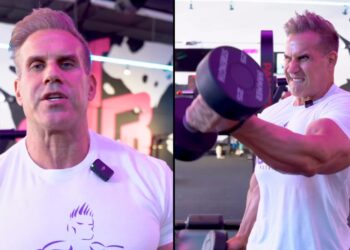Close your eyes and think about an ideal free-weight chest workout. Chances are the training session includes the bench press, dumbbell press, dumbbell fly, and some variation of the incline or decline fly. All these exercises share something in common — they require a bench.
Busy folks that train during rush hours might not have the luxury of waiting for a bench. On the other hand, people that work in their minimal garage gyms might not have access to a bench.
Contrary to what most lifters think, you can train your pecs effectively without a bench with free weights; one of the best exercises to do this is the standing dumbbell fly.
Whether you don’t want to wait for your turn on the bench, don’t have a bench in your home gym, or want to try a new exercise to spark chest growth, the standing dumbbell fly has you covered.
The standing dumbbell fly is a versatile exercise that can be included in your chest, push, upper body, or full-body workouts. This movement demands decent core stability to perform correctly. Furthermore, going too heavy on the standing dumbbell fly can render the exercise ineffective.
You must follow a slow and controlled range of motion while using moderate weights to make the most of the standing dumbbell fly, making it an excellent exercise for beginners. It will also help improve your mind-muscle connection, which will carry over to other lifts.
Level Up Your Fitness: Join our 💪 strong community in Fitness Volt Newsletter. Get daily inspiration, expert-backed workouts, nutrition tips, the latest in strength sports, and the support you need to reach your goals. Subscribe for free!
In this article, we cover everything you need to learn about the standing dumbbell fly to make the most of this lift, including its benefits, the common mistakes, the muscles worked, how to perform correctly, and the best variations and alternatives.
What is a Standing Dumbbell Fly?
Developed pectoral muscles take your physique aesthetics to the next level. They add to your V-taper, draw eyes to your midsection, and improve your overall functionality. However, most lifters leave gains on the table during their chest workout as they chase weights and forget about using a full range of motion and contracting their muscles with each rep. The unique setup of the standing dumbbell fly fixes this. This exercise also improves your stability and balance. Furthermore, the range of motion of the standing dumbbell fly will make you strong enough to lift the love of your life in your arms.
The standing dumbbell fly is a standing low to high cable fly variation. To perform a standing dumbbell fly, assume a hip-width stance while holding a dumbbell in each hand. Maintain an upright torso, push your chest out, and raise your hands to shoulder level while maintaining a slight bend in your elbows.
You could also turn this exercise into a unilateral movement by working one side of your body at a time. Unilateral exercises are incredibly effective at fixing muscle and strength imbalances. While doing the single-arm variation of this lift, keep your other hand on your hip or hold onto a dumbbell for better balance.
Muscles Worked During Standing Dumbbell Fly
The standing dumbbell fly works the following muscles:
Chest
The pectoralis muscle consists of two muscles, the pectoralis major and the pectoralis minor. The pectoralis major is a fan-shaped superficial muscle in the front of your chest wall. On the other hand, the pectoralis minor is triangular and located under the pectoralis major.
The standing dumbbell flys mainly target the pectoralis major, which helps with the adduction, or depression, of the arm and arm rotation forward about the axis of the body.
Shoulders
The standing dumbbell fly is an isolation exercise that restricts movement to the shoulder joint. Since this exercise involves movement in the sagittal plane, it results in anterior deltoid recruitment.
Biceps
This dumbbell fly variation involves maintaining a slight bend in your elbows throughout the range of motion. You might experience a slight biceps engagement during the movement’s concentric (upward) part while performing this exercise, especially while lifting heavy.
Benefits of Standing Dumbbell Fly
Adding the standing dumbbell fly to your exercise arsenal entails the following advantages:
Helps Build Muscle Mass
The standing dumbbell fly is an isolation exercise that can help build muscle mass and improve your conditioning. Perform 3-5 sets and 8-12 reps of this exercise once weekly using appropriate weight to induce hypertrophy. [1]
Beginner-Friendly
This dumbbell fly variation involves lifting light to moderate weights while focusing on your form, making it an excellent exercise for beginners. You must readjust your form if you don’t feel your chest muscles contracting with each rep. Use this exercise as an opportunity to polish your mind-muscle connection.
Variety
Most free-weight chest exercises require lying on a bench. The unique stimulus of the standing dumbbell flies can shock your muscles, sparking new muscle tissue growth. Plus, it is a versatile exercise that can be added as an accessory lift in most training programs. Since it requires only dumbbells, the standing dumbbell fly is incredibly convenient.
How To Do Standing Dumbbell Fly
This is how to perform the standing dumbbell fly with the correct form:
Steps:
- Stand upright with a shoulder-wide stance.
- Grab a dumbbell in each hand with a supinated (palms facing forward) grip.
- Tuck your chin slightly, pull your shoulders back and down, and push out your chest.
- Maintain a slight bend in your elbows and lift your arms toward the ceiling until your hands are at shoulder level.
- Your hands should move toward the center line of your body during the upward motion and should be next to each other at the top.
- Focus on contracting your pecs throughout the range of motion.
- Pause and squeeze the life out of your chest at the top.
- Slowly return to the starting position.
- Repeat for recommended reps.
Standing Dumbbell Fly Tips:
- Avoid touching the dumbbells at the top, as it will remove the tension from your chest and put it on your shoulders.
- Keep your core and glutes braced throughout the range of motion for optimal stability and balance.
- Many lifters make the mistake of extending their elbows at the bottom. Your elbows should be slightly bent throughout the ROM.
- Breathe in during the concentric (upward) motion and exhale during the eccentric (downward) motion.
- To prevent trapezius muscle activation, refrain from shrugging your shoulders as you lift your arms.
In This Exercise:
- Target Muscle Group: Chest
- Secondary Muscle Groups: Shoulders and Biceps
- Type: Strength
- Mechanics: Isolation
- Equipment: Dumbbells
- Difficulty: Beginner
- Best Rep Range: 8-12
Common Mistakes While Performing Standing Dumbbell Fly
Avoid these lapses to make the most of the standing dumbbell fly:
Level Up Your Fitness: Join our 💪 strong community in Fitness Volt Newsletter. Get daily inspiration, expert-backed workouts, nutrition tips, the latest in strength sports, and the support you need to reach your goals. Subscribe for free!
Going Too Heavy
The standing dumbbell fly is an isolation exercise. Using heavier dumbbells than you can handle comfortably can remove tension from your pecs and put it on your shoulders and biceps. For optimal results on this lift, use a moderate weight and focus on contracting your pecs with every rep.
Leaning Forward
Many lifters tend to lean forward while performing this exercise. However, it can result in greater deltoid engagement and remove tension from your chest. You must maintain an upright torso and push your chest out to work your pecs.
Holding the Dumbbells Too Tight
Squeezing the dumbbell handles too hard can fire up your forearms and biceps. Additionally, since you’ll maintain a slight bend in your elbows, it can result in a biceps pump. Use a false (thumbless) grip if you feel excessive forearm engagement while performing this exercise.
Variations and Alternatives of Standing Dumbbell Fly
Add the following standing dumbbell fly variations and alternatives to your training regimen to build a full and round chest:
Standing Low To High Cable Fly
This chest movement is the closest alternative to the standing dumbbell fly exercise. The cables help keep constant tension on your muscles throughout the range of motion.
Steps:
- Set the cable pulleys at the lowest setting and hook up a D-handle attachment.
- Grab a handle in each hand, walk to the pulley machine’s center, and then take a step forward. The cable should be taut at the starting position.
- Your hands should be at the sides of your thighs at the starting position.
- While maintaining a slight bend in your elbows, lift your arms until your hands are at shoulder level.
- Pause and contract your pecs throughout the range of motion.
- Slowly return to the starting position.
- Rinse and repeat.
Pro Tip: Slow down the exercise’s eccentric (lowering) motion for optimal pectoral engagement.
Pec Deck Fly
Since the pec deck fly machine follow a fixed movement path, it is a beginner-friendly chest exercise. The fixed movement trajectory allows you to focus on establishing a mind-muscle connection with your pectoral muscles and contracting them throughout the ROM.
Steps:
- Set the seat of the pec deck machine at a height so that the machine handles are at shoulder level.
- Grab the handles with a neutral (palms facing inward) grip.
- Push out your chest slightly.
- While maintaining a slight bend in your elbows, bring your hands together.
- Pause and contract your pecs at the top.
- Slowly return to the start position.
Pro Tip: Keep your shoulder blades pinched throughout the exercise. Rounded shoulders take tension off your pecs.
Check out our complete pec deck fly guide here!
Barbell Fly
Although this exercise requires barbells, it is a bodyweight movement. Besides annihilating your pecs, the barbell fly will engage your core and help improve your balance and stability.
Steps:
- Place two barbells together on the floor.
- Add a weight plate on the same end of both barbells.
- Get into a push position while holding the barbells a few inches below their necks on the weighted sides.
- The non-weighted ends of the bars should be between your feet.
- Slowly roll out the bars and lower your chest as close to the floor as possible.
- Pause at the bottom.
- Bring the bars back to the starting position. Pause and contract your pecs at the top.
- Repeat for reps.
Pro Tip: Place a weight plate on each side to keep the bars from rolling too far out. The weight plates on the floor will act as guard rails.
Check out our complete barbell fly guide here!
Flat Bench Dumbbell Fly
This is a staple exercise in most chest training routines. It helps develop your inner chest, giving it a fuller appearance.
Steps:
- Lie supine on a flat bench while holding a dumbbell in each hand with a neutral grip.
- Extend your arms so they are perpendicular to the floor.
- While maintaining a slight bend in your elbows, lower your arms to your sides.
- Pause at the bottom.
- Explode back to the starting position. Contract your pecs at the top.
- Rinse and repeat.
Pro Tip: Keep your rhomboids pinched together as if holding a pencil between them. This will improve your chest stimulation.
Check out our complete flat bench dumbbell fly guide here!
Incline Dumbbell Fly
The upper pecs are a lagging muscle group for most lifters. Not only does the incline dumbbell fly improve your upper shelves, but it also enhances your muscle separation.
Steps:
- Set the back of an incline bench at a 45-degree angle with the floor.
- Lie on the bench holding a dumbbell in each hand using a neutral grip.
- Extend your arms so they are perpendicular to the floor.
- While maintaining a slight bend in your elbows, slowly lower the bar toward the floor.
- Return to the starting position.
- Repeat for reps.
Pro Tip: Many lifters make the mistake of holding the dumbbells at an angle, which removes tension from their chest and puts in on their anterior deltoids. Your arms should be at a 90-degree with the floor for optimal chest engagement.
Check out our complete incline dumbbell fly guide here!
Wrapping Up
The standing dumbbell fly is an unorthodox exercise that can spark new growth in your chest. Perform 3-5 sets of 8-12 reps of this exercise with moderate weights to put you in the sweet spot for gaining muscle mass and conditioning.
You must follow a full range of motion to get optimal results. Furthermore, switch this exercise with the alternatives and variations mentioned in this article to target your pectoral muscles from different angles and fast-track your pectoral growth.
References
- Krzysztofik M, Wilk M, Wojdała G, Gołaś A. Maximizing Muscle Hypertrophy: A Systematic Review of Advanced Resistance Training Techniques and Methods. Int J Environ Res Public Health. 2019 Dec 4;16(24):4897. doi: 10.3390/ijerph16244897. PMID: 31817252; PMCID: PMC6950543.
Interested in measuring your progress? Check out our strength standards for Bench Press, Incline Dumbbell Fly, Cable Fly, and more.








